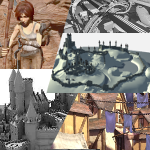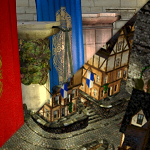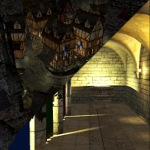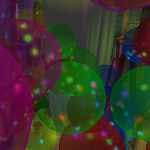- 2018
Tutorial - Voxel DAGs and Multiresolution Hierarchies: From Large-Scale Scenes to Pre-computed Shadows

AbstractIn this tutorial, we discuss voxel DAGs and multiresolution hierarchies, which are representations that can encode large volumes of data very efficiently. Despite a significant compression ration, an advantage of these structures is that their content can be efficiently accessed in real-time. This property enables various applications. We begin the tutorial by introducing the concepts of sparsity and of coherency in voxel structures, and explain how a directed acyclic graph (DAG) can be used to represent voxel geometry in a form that exploits both aspects, while remaining usable in its compressed from for e.g. ray casting. In this context, we also discuss extensions that cover the time domain or consider an advanced encoding strategies exploiting symmetries and entropy. We then move on to voxel attributes, such as colors, and explain how to integrate such information with the voxel DAGs. We will provide implementation details and present methods for efficiently constructing the DAGs and also cover how to efficiently access the data structures with e.g. GPU-based ray tracers. The course will be rounded of with a segment on applications. We highlight a few examples and show their results, and delve into one special application: compressed pre-computed shadows.
(Slides available for download via the "More..." link.)AuthorsUlf Assarsson, Markus Billeter, Dan Dolonius, Elmar Eisemann, Alberto Jaspe, Leonardo Scandolo & Erik Sintorn
Presentedat Eurographics 2018
- 2015
Course - Real-Time Many-Light Management and Shadows with Clustered Shading

AbstractUsing many lights in real-time applications has been an important goal for many years. The games industry, in particular, has strived to increase the number of lights to provide enhanced visual quality and realism. Today, high-end games often make use of hundreds of lights in each frame, and the number of lights is likely to expand in the future. The ability to efficiently manage and shade large numbers of lights presents many possibilities, apart from simply allowing light to be cast from many dynamic objects. It can also support visualizing global illumination solutions, or enable detailed artistic light direction.
This course presents an in-depth exploration of many-light management, starting with background and progressing to state-of-the-art research, including recent results on supporting shadows. The course combines production experience from game developers with the latest research into efficient many-light algorithms for both desktop and mobile hardware.
(Slides available for download via the "More..." link.)AuthorsOla Olsson, Emil Persson & Markus Billeter
Presentedat SIGGRAPH 2015
- 2014
Course - Efficient Real-Time Shading with Many Lights

AbstractUsing many lights in real-time applications has been an important goal for many years. The games industry in particular has strived to increase the number of lights to provide enhanced visual quality and realism. Today, high-end games often make use of hundreds of lights in each frame, and this is likely to be pushed further in the future. The ability to efficiently manage and shade large numbers of lights brings many possibilities, apart from simply allowing light to be cast from many dynamic objects. In addition, it can support visualizing global illumination solutions, or enable detailed artistic light direction. Thus, efficient real-time shading with many lights, represents a potential for solving many of the problems facing the development of next generation high-end games. To achieve the level of performance needed to make this possible, the way which light management and shading is performed has undergone dramatically development in recent years. Both industry and academia has invested great effort pursuing this goal, which has resulted in a large number of new and sometimes competing techniques.
This course presents an in-depth exploration of this topic, starting with background and leading up to state of the art research, including recent results on supporting shadows. The course combines production experience from game developers with the latest research into efficient many-light algorithms for both desktop and mobile hardware.
(Slides available for download via the "More..." link.)AuthorsOla Olsson, Emil Persson & Markus Billeter
Presentedat SIGGRAPH Asia 2014
Implementing Efficient Virtual Shadow Maps for Many Lights

AbstractIn the past few years, several techniques have been presented that enable real-time shading using many hundreds or thousands of lights [Harada et al. 2013]. However, only recently has a comprehensive study including shadows been presented by Olsson et al. [2014], where real-time performance is achieved for several hundred light sources with high quality and controllable memory footprint. The new algorithm uses many modern features of OpenGL and contains many design choices only described very briefly in the paper. We present additional details and focus on the practical implementation aspects of the system, in order to facilitate the implementation of the algorithm for the game development community.
AuthorsOla Olsson, Erik Sintorn, Viktor Kämpe, Markus Billeter & Ulf Assarsson
Presentedat SIGGRAPH 2014 Talks
- 2012
Tiled and Clustered Forward Shading

AbstractTiled and Clustered Forward Shading are new techniques that enable support for thousands of lights, while eliminating many of the drawbacks of deferred techniques. This talk shows how these techniques can be used and extended to support transparency with high efficiency.
AuthorsOla Olsson, Markus Billeter & Ulf Assarsson
Presentedat SIGGRAPH 2012 Talks
- 2009
GPU Primitives - Case Study: Hair Rendering

AbstractCase study that talks about GPU primitives and their application in rendering. Specifically, our sorting was used to accelerate the hair rendering implemented by Erik Sintorn.
AuthorsUlf Assarsson, Markus Billeter, Ola Olsson & Erik Sintorn
Presentedat Beyond Programmable Shading Course, SIGGRAPH 2009
